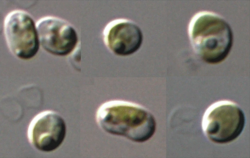Biology:Choricystis
| Choricystis | |
|---|---|

| |
| Choricystis krienitzii | |
| Scientific classification | |
| (unranked): | Viridiplantae |
| Division: | Chlorophyta |
| Class: | Trebouxiophyceae |
| Order: | incertae sedis |
| Family: | Coccomyxaceae |
| Genus: | Choricystis (Skuja) Fott, 1976[1] |
| Type species | |
| Choricystis minor | |
| Species[1] | |
| |
Choricystis is a genus of green algae in the class Trebouxiophyceae, considered a characteristic picophytoplankton in freshwater ecosystems.[1][3] Choricystis, especially the type species Choricystis minor (species), has been proposed as an effective source of fatty acids for biofuels.[4][5][6] Choricystis algacultures have been shown to survive on wastewater.[7][8] In particular, Choricystis has been proposed as a biological water treatment system for industrial waste produced by the processing of dairy goods.[7]
Choricystis have been found in natural bodies of water in South America,[5] North America, Europe, Asia, and Antarctica.[9] They have been observed as an endosymbiont of freshwater sponges as well as ciliates like Paramecium bursaria.[10][11][12]
Use as a biofuel
Triglycerides and other lipids can be transesterified to produce fatty acid methyl esters, the primary component of biodiesel fuels.[13][14] Because of their high lipid content and rate of lipid production, Choricystis algae have been suggested as effective microalgae for industrial biofuel production.[4][5][6][15][16] Molecular profiles of C. minor have noted its high proportion of neutral (as opposed to polar) lipids,[4][8][17][18] considered preferable in biodiesel production.[8][19]
See also
References
- ↑ 1.0 1.1 1.2 Guiry, M.D.; Guiry, G.M. (2008). "Choricystis". AlgaeBase. World-wide electronic publication, National University of Ireland, Galway. http://www.algaebase.org/browse/taxonomy/?id=44977.
- ↑ Pröschold, T.Expression error: Unrecognized word "etal". (2011). "The systematics of Zoochlorella revisited employing an integrative approach". Environmental Microbiology 13 (2): 350–364. doi:10.1111/j.1462-2920.2010.02333.x. PMID 20874732.
- ↑ Krienitz, L.; Huss, V.A.R.; Hümmer, C. (1996). "Picoplanktonic Choricystis species (Chlorococcales, Chlorophyta) and problems surrounding the morphologically similar 'Nannochloris-like algae'". Phycologia 35 (4): 332–341. doi:10.2216/i0031-8884-35-4-332.1.
- ↑ 4.0 4.1 4.2 Sobczuk, T.M.; Chisti, Y. (2010). "Potential fuel oils from the microalga Choricystis minor". Journal of Chemical Technology and Biotechnology 85 (1): 100–108. doi:10.1002/jctb.2272.
- ↑ 5.0 5.1 5.2 Menezes, R.S.; Soares, A.T.; Marques, J.G.; Lopes, R.G.; de Arantes, R.F.; Derner, R.B.; Filho, N.R.A. (2016). "Culture medium influence on growth, fatty acid, and pigment composition of Choricystis minor var. minor: a suitable microalga for biodiesel production". Journal of Applied Phycology 28 (5): 2679–2686. doi:10.1007/s10811-016-0828-1.
- ↑ 6.0 6.1 Riveira, C.Y.B.; D'Alessandro, E.B.; Filho, N.R.A.; Lopes, R.G.; Derner, R.B. (2021). "Synergistic effect of growth conditions and organic carbon sources for improving biomass production and biodiesel quality by the microalga Choricystis minor var. minor". Science of the Total Environment 759: 143476. doi:10.1016/j.scitotenv.2020.143476. PMID 33218810. Bibcode: 2021ScTEn.759n3476O.
- ↑ 7.0 7.1 Tsolcha, O.N.; Tekerlekopoulou, A.G.; Akratos, C.S.; Bellou, S.; Aggelis, G.; Katsiapi, M.; Moustaka-Gouni, M.; Vayenas, D.V. (2015). "Treatment of second cheese whey effluents using a Choricystis-based system with simultaneous lipid production". Journal of Chemical Technology and Biotechnology 91 (8): 2349–2359. doi:10.1002/jctb.4829.
- ↑ 8.0 8.1 8.2 Chen, Y.; Li, X.; Sun, Z.; Zhou, Z. (2017). "Isolation and identification of Choricystis minor Fott and mass cultivation for oil production". Algal Research 25: 142–148. doi:10.1016/j.algal.2017.05.012.
- ↑ Zidarova, R.; Pouneva, I. (2006). "Physiological and biochemical characterization of antarctic isolate Choricystis minor during oxidative stress at different temperatures and light intensities". General and Applied Plant Physiology (Bulgarian Academy of Sciences): 109–115. http://www.bio21.bas.bg/ippg/bg/wp-content/uploads/2011/06/06_pisa_109-115.pdf.
- ↑ Pröschold, T.; Darienko, T. (2020). "Choricystis and Lewiniosphaera gen. nov. (Trebouxiophyceae Chlorophyta), two different green algal endosymbionts in freshwater sponges". Symbiosis 82 (3): 175–188. doi:10.1007/s13199-020-00711-x. PMID 33328698.
- ↑ Kulakova, N.V.; Kashin, S.A.; Bukin, Y.S. (2020). "The genetic diversity and phylogeny of green microalgae in the genus Choricystis (Trebouxiophyceae, Chlorophyta) in Lake Baikal". Limnology 21: 15–24. doi:10.1007/s10201-019-00587-x.
- ↑ Flemming, F.E.; Potekhin, A.; Pröschold, T.; Schrallhammer, M. (2020). "Algal Diversity in Paramecium bursaria: Species Identification, Detection of Choricystis parasitica, and Assessment of the Interaction Specificity". Diversity 12 (8): 287. doi:10.3390/d12080287.
- ↑ Fukuda, H.; Kondo, A.; Noda, H. (2001). "Biodiesel fuel production by transesterification of oils". Journal of Bioscience and Bioengineering 92 (5): 405–416. doi:10.1016/S1389-1723(01)80288-7. PMID 16233120.
- ↑ Meher, L.C.; Vidya Sagar, D.; Naik, S.N. (2006). "Technical aspects of biodiesel production by transesterification—a review". Renewable and Sustainable Energy Reviews 10 (3): 248–268. doi:10.1016/j.rser.2004.09.002.
- ↑ Menezes, R.S.Expression error: Unrecognized word "etal". (2015). "Evaluation of fatty acid composition of the microalgae Choricystis minor var. minor according to two different nutrient feeding strategies". Journal of Renewable and Sustainable Energy 7 (4): 043117. doi:10.1063/1.4926908.
- ↑ Menezes, R.S.Expression error: Unrecognized word "etal". (2022). "Production and quality assessment of biodiesel obtained by thermal process from wet microalgae biomass of Choricystis minor var. minor". Biofuels 13 (9): 1103–1111. doi:10.1080/17597269.2022.2106641.
- ↑ da Cruz Lima, A.A.Expression error: Unrecognized word "etal". (2018). "Choricystis minor var. minor lipids: Extraction using conventional and pressurized solvents and assessment of their potential to produce fatty acid methyl esters". Algal Research 33 (12): 28–35. doi:10.1016/j.algal.2018.04.017.
- ↑ Pikoli, M.R.; Sari, A.F.; Solihat, N.A.; Permana, A.H. (2019). "Characteristics of tropical freshwater microalgae Micractinium conductrix, Monoraphidium sp. and Choricystis parasitica, and their potency as biodiesel feedstock". Heliyon 5 (12): e02922. doi:10.1016/j.heliyon.2019.e02922. PMID 31867456. Bibcode: 2019Heliy...502922P.
- ↑ Bertozzini, E.; Galluzzi, L.; Penna, A.; Magnani, M. (2011). "Application of the standard addition method for the absolute quantification of neutral lipids in microalgae using Nile red". Journal of Microbiological Methods 87 (1): 17–23. doi:10.1016/j.mimet.2011.06.018. PMID 21767582.
Wikidata ☰ Q5105054 entry
 |

